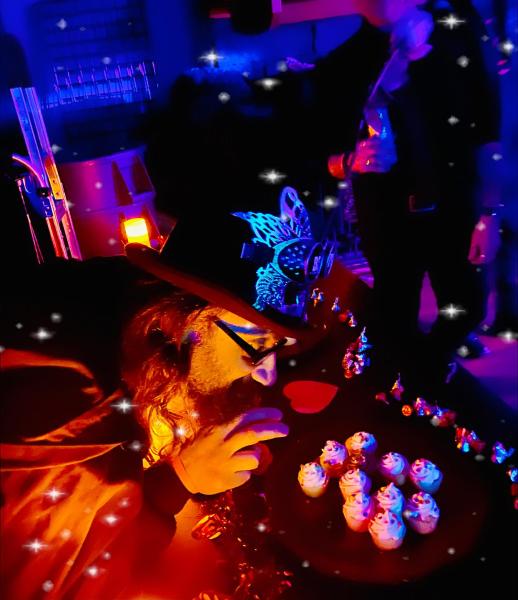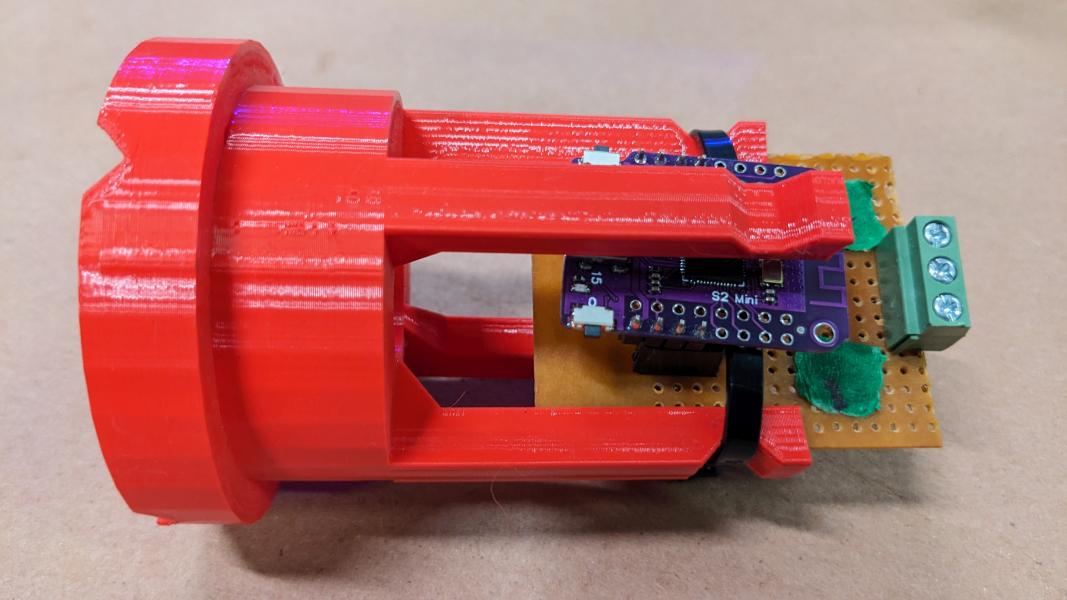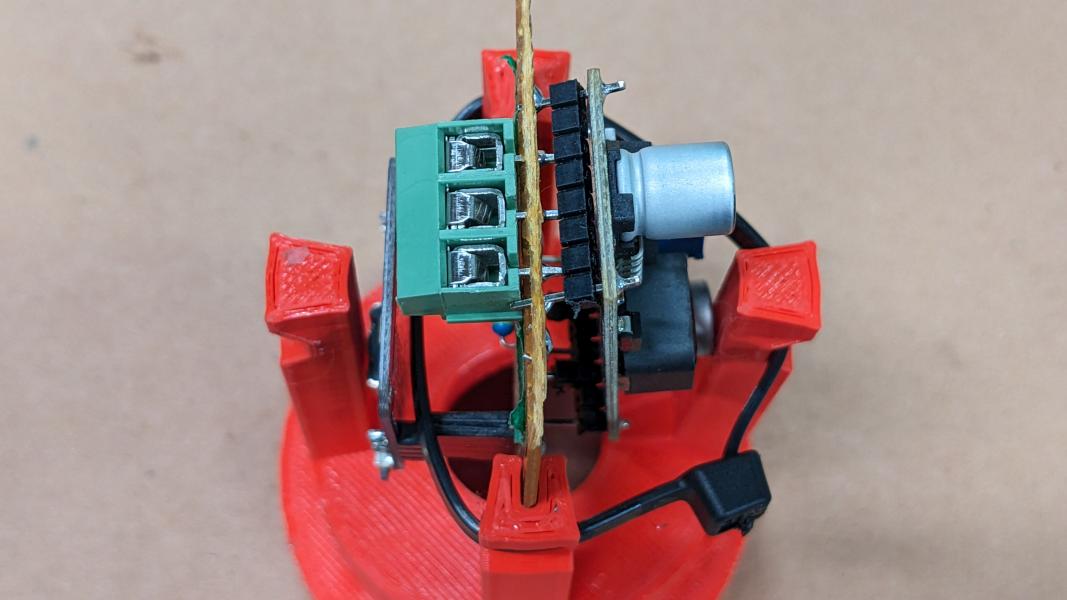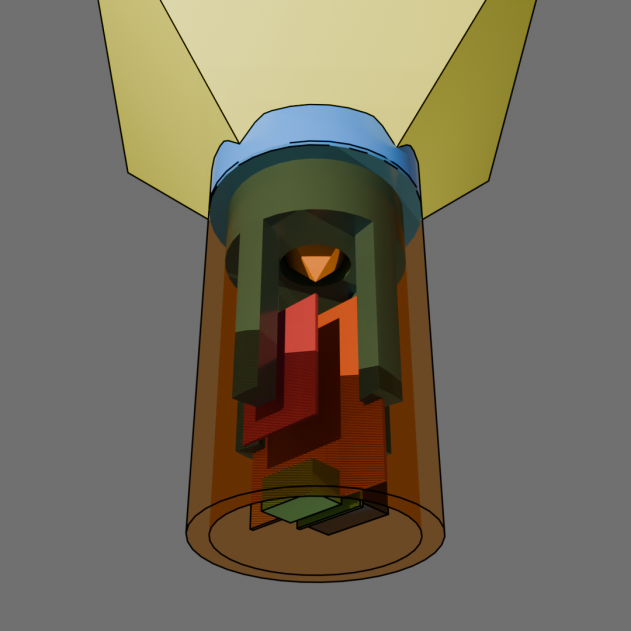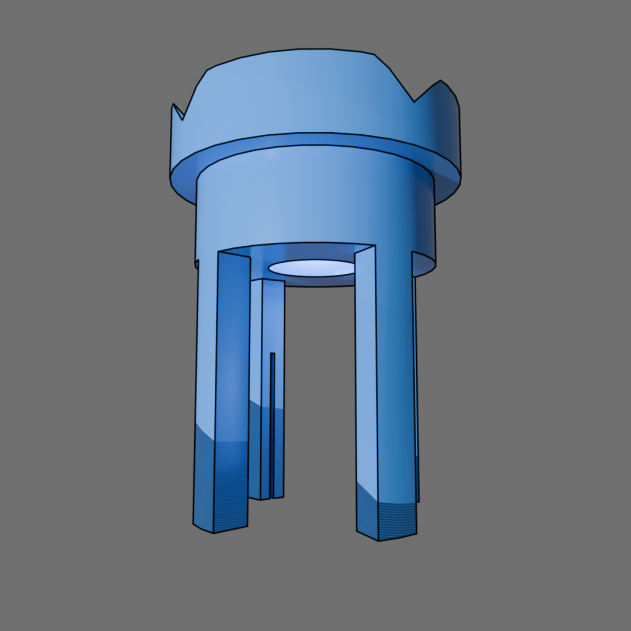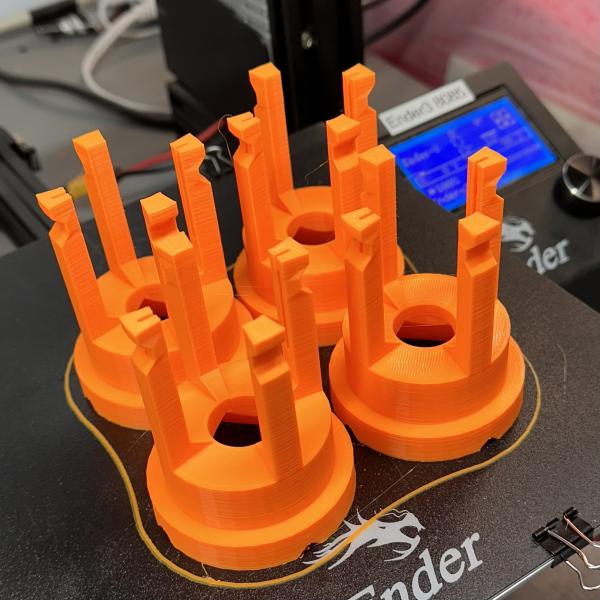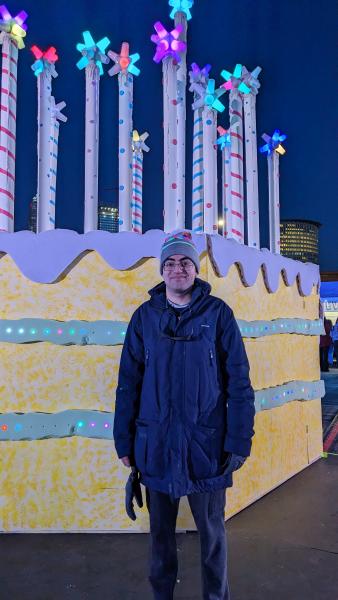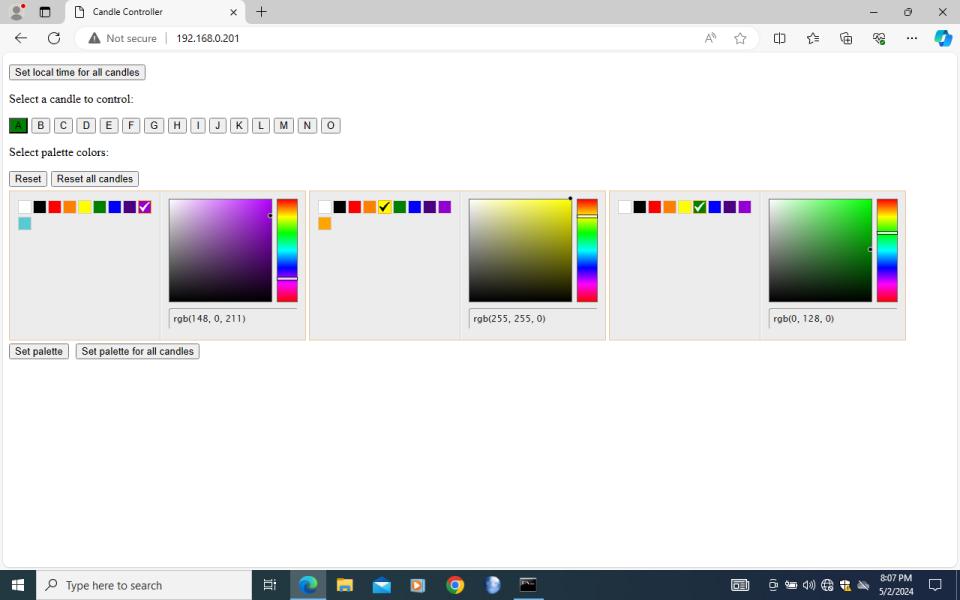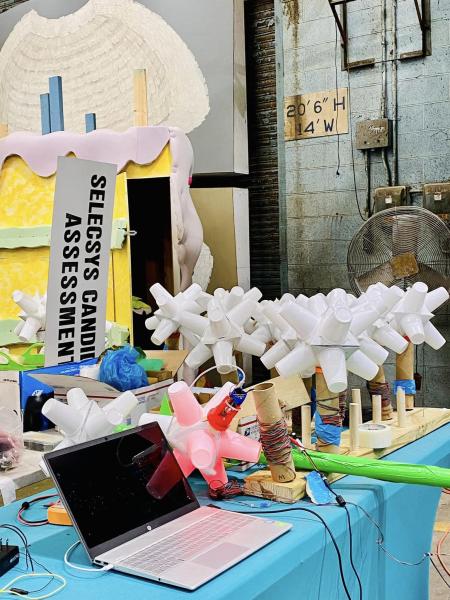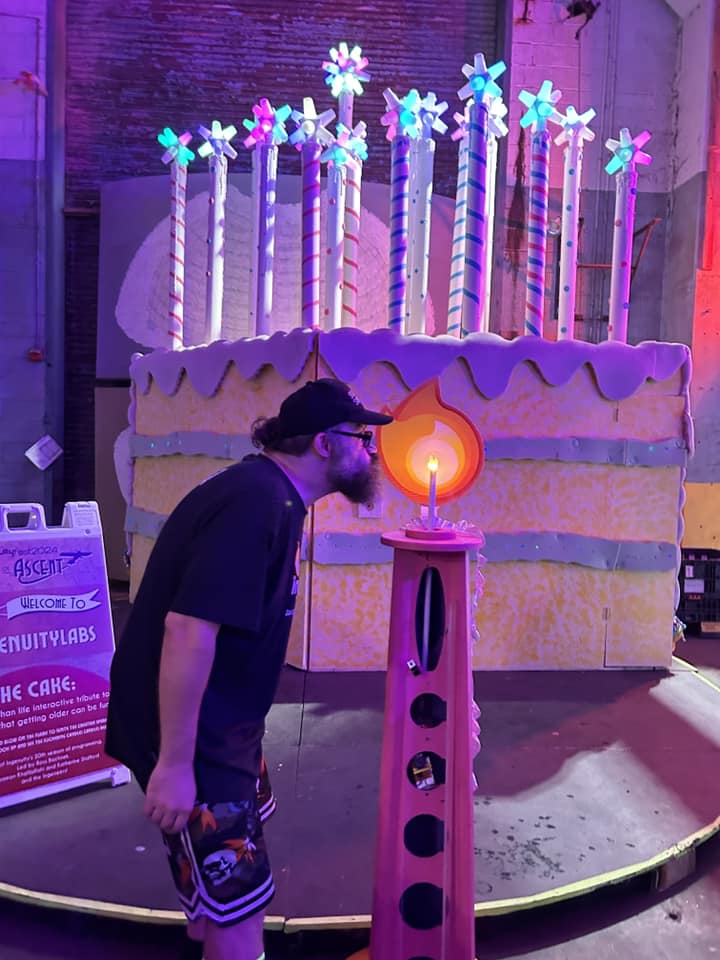Ingenuity: Team Cake
Content Warning: The following page contains math and engineering content for nerdy audiences. Reader discretion is advised.Since moving to Cleveland in the summer of 2023, I like to think that I fell in with the right crowd, or at least an interesting one. I had read on the internet about how "community makerspaces" seemed to be hubs of fascinating people and projects, and an internet search quickly found the Makers' Alliance, a partner of Ingenuity Cleveland. I came to a couple of the meetings, but didn't initially find much that I could help with. This changed when some of the regular members began to discuss this "Brite Winter" thing; when I asked what it was, they said "Come on Thursday!" (to the Ingenuity general meeting), and so I did.
This cake is no lie
Of the projects selected for the festival, I signed on with one headed by the multitalented Ross Bochnek (of Splendid Dimensions), which aimed to construct a supersized wooden birthday cake with 15 candles to celebrate Brite Winter's 15th year. The two remaining "slices" of cake [1] would be about 6 feet high, with the candles towering several additional feet over festivalgoing crowds, and the candles were to be topped with eight-sided blinking LED "flames", which I was to write firmware for. Additional lights were mounted in the "frosting" strips between the layers, which were setup and programmed by Robert Wadsworth.
Ross, seen here performing a difficult rite of cake magic, wears many hats, including this custom steampunk one.
Early on, we decided that each "flame" would have its own microcontroller hidden in the candle stem. This was done both to reduce the signal wiring complexity and to create a more modular and reusable design (indeed, Ross was later able to use an individual candle as a torch for a parade). Ross designed a microcontroller carrier which integrated the 12v → 3.3v buck regulator and routed the wires to appropriate pins; we took to calling these "brain boards". The controllers themselves were WEMOS S2 minis, which are smaller and cheaper than full-fat ESP32 dev boards, but have most of the same functionality.
The weeks in the run-up to Brite Winter were spent cutting out, painting, shellaccing, and folding the cardboard octahedra and their LED diffuser housings (aka white plastic cups). They were then hot-glued into 3D-printed bases that slid into the candle tubes, which were graciously designed by Ed Morra:
Time to shine
February 24 was a clear, cold Saturday in the Flats as the initial set of bands took their stages. This included the Cleveland School of Rock [2] on the outdoor Cleveland Scene Stage as well as The Baker's Basement and their Wild Wild Sheep in the Duck Art Tent.
Initially, I was worried by the fact that the LEDs weren't visible in the bright sunlight, but as dusk fell, they came into view, and I found myself fairly pleased with the result. The lights stood out against the night sky, forming a landmark that could be seen from across the festival grounds.
Thanks again to Nadia Hamel for taking this picture, and for insisting we go back out and take pictures by the cake in the first place.
Part deux: Bal Ingenieux
Ross and I had planned from the beginning to add some kind of interactive element to the candles, a task made more difficult by the candles' placement out of festivalgoers' reach. We decided on an initial design based on having users select color palettes for the candles.
This involved constructing an ESP32-based web server which, while far from an unheard-of task, was made more complicated by the need to also serve non-trivial webpage assets, including jQuery and the jQuery Spectrum color picker. This involved a bit of finangling, and I ended up storing them as strings in flash memory, and making server-side "templates" with snprintf:
const char INDEX_HTML_TEMPLATE[] PROGMEM = R"INDEX_HTML_EOF(
<!DOCTYPE html>
<html lang="en">
<head>
<title>Candle Controller</title>
...
<script type="text/javascript">
$(() => {
const numCandles = %d;
...
</html>
...
)INDEX_HTML_EOF";
void index_html_render(WebServer& server, size_t numCandles)
{
char* responseBuf = new char[sizeof(INDEX_HTML_TEMPLATE) + 20];
snprintf(responseBuf, sizeof(INDEX_HTML_TEMPLATE) + 20, INDEX_HTML_TEMPLATE, numCandles);
server.send(200, "text/html", responseBuf);
delete[] responseBuf;
}
The candles themselves were addressed using a fixed IP address scheme, as hardcoding DNS records into the router seemed like additional complexity for not much gain, and mDNS, while theoretically supported by the ESP32 platform, had always been flaky in my experience. The scheme first obtained a default address automatically using DHCP, then, assuming that the network is at least a /24, assigns itself the last octet based on its assigned letter starting from 201 (so candle A will have xx.yy.zz.201, B will have xx.yy.zz.202, and so on). The rest was fairly straightforward web development, and the result looked reasonable, if not too flashy:
A few additional goodies also went into the firmware: The "rare white pulse" animation from Brite Winter was replaced with a visual "carillon clock" effect which would chime every fifteen minutes and ring the hour. This required the controller clocks to be synced to the correct time (ideally within a small fraction of a second so that the animations would fire in lockstep). The ESP32 standard library supports network time protocol (NTP) syncing, which is the standard approach for this, but upon discovering that wiring the installation for internet access would be inconvenient at best, I decided to have the web interface sync the clocks using the client device's time (obtained through JavaScript). This became the button at the top of the screenshot.
The source code used for the candle firmware, as well as Robert's firmware for the layer strip lighting, are available on GitHub: picode98/brite-winter-2024-cake-candles
At this point, all we needed was a wireless router to network the ESPs and a laptop to display the controller website, both of which the Makers Alliance had spares of. The Saturday before the Bal was spent programming and installing the candles:
Credit: Facebook/The Ingeneers
The Bal itself saw me reprise the "punk rocker" costume I had created for an office Halloween costume contest, while the cake served as a backdrop to the lounge area across from the dance floor. I kept an eye on the setup, but it didn't really need any maintainance beyond waking the laptop display back up occasionally, which meant I got to enjoy festivities such as the Fashion Rocks runway (prepared by Jacci Hammer and Hammertime Productions) and aerial gymnastics by Crooked River Circus.
Post-Bal review and design revision
Although the interactivity did work during the Bal, it didn't prove to be as much of an attraction as we had hoped. This was probably in part due to the nature of the event (a dance party crowd not being too likely to be attracted to interactive exhibits), but another factor was that the user experience was also clunkier than optimal for a public-facing setup, as it required clicking around on a laptop with the small touchpad below the keyboard. Thus, we began to consider other approaches as we began to prepare for IngenuityFest 2024 in September.
In the end, we opted for something simple: a small flame that could be "blown out" which would in turn blow out the candles on the cake itself. The simplicity was partly to cater to festival crowds with a lot of other things to see, and partly because Ross and I were both fairly time-constrained, as we were both working on other festival projects. [3] Further, five additional candles needed to be manufactured in order to bring the total to 20 for the 20th year of IngenuityFest, one of which would be an 20-sided "mega flame" that would crown the highest candle.
Software Revisions
The initial software approach involved simply adding another HTTP endpoint to the existing server that would start a "blowout" animation. I put my 4-year math degree to use for this one, using a biased random walk to try to emulate a real flame's appearance:
for(size_t i = 0; i < NUM_LEDS; ++i) // Animation runs seperately for each LED.
{
BLOW_OUT_VELOCITY_SEGMENT_TIME[i] += delta; // where delta is the time in seconds since the last animation update
if(BLOW_OUT_VELOCITY_SEGMENT_TIME[i] >= 0.05)
{
BLOW_OUT_BRIGHTNESS_VELOCITY[i] = 20.0 * ( // velocity scaling factor
(static_cast<double>(random(INT_MAX)) / (INT_MAX - 1)) // random number in the range [0, 1] inclusive
- 0.5 // shift range to [-0.5, 0.5] inclusive
- CURRENT_ANIM_TIME / (2.0 * (BLOW_OUT_ANIM_LENGTH - BLOW_OUT_DARK_TIME)) // subtract up to an additional 0.5 as the animation progresses to make the flames
// likely to flicker out
);
BLOW_OUT_VELOCITY_SEGMENT_TIME[i] = fmod(BLOW_OUT_VELOCITY_SEGMENT_TIME[i], 0.05); // Keep the remainder for timing accuracy.
}
BLOW_OUT_BRIGHTNESS[i] = min(max(BLOW_OUT_BRIGHTNESS[i] + BLOW_OUT_BRIGHTNESS_VELOCITY[i] * delta, 0.0), 1.0); // Step brightnesses by velocity, clipping to [0, 1].
}
The animation seemed to work, but early testing, showed that triggering it via HTTP request for each of the 20 candles wouldn't be fast enough (at least, not without some fairly complicated asynchronous code), so I bit the bullet and went back to basics, rewriting it to use good old BSD sockets with a UDP broadcast:
// Setup
struct sockaddr_in sourceAddr;
sourceAddr.sin_addr.s_addr = htonl(INADDR_ANY);
sourceAddr.sin_family = AF_INET;
sourceAddr.sin_port = htons(81);
int newSocket = socket(AF_INET, SOCK_DGRAM, IPPROTO_UDP);
const int broadcastPermission = 1;
setsockopt(newSocket, SOL_SOCKET, SO_BROADCAST, &broadcastPermission, sizeof(broadcastPermission));
bind(newSocket, reinterpret_cast<struct sockaddr*>(&sourceAddr), sizeof(sourceAddr));
// When blowing out the candles
struct sockaddr_in destAddr;
destAddr.sin_addr.s_addr = htonl(IPADDR_BROADCAST);
destAddr.sin_family = AF_INET;
destAddr.sin_port = htons(81);
const uint8_t payload[] = { 3 };
auto bytesSent = sendto(newSocket, payload, sizeof(payload), 0, reinterpret_cast<struct sockaddr*>(&destAddr), sizeof(destAddr));
I used 3 as the single-byte payload here because future improvements might add physical controls and commands for the other functionality exposed by the web interface: Blinking the candle would be command 0, setting the time would be command 1, and setting the color palette would be command 2.
For a hardware approach, we experimented with humidity sensors and microphones, but finally settled on a "pendulum" that would physically swing when blown on, with the flame (a chip-on-board unit with an LED that flickered by itself) mounted on top. The swing would be detected by an infrared breakbeam sensor built into a small plastic channel; this would cause the ESP32 to send the UDP packet to blow out the cake candles and pull a transistor open to blow out the small flame.
Ross also expressed interest in adding OTA-update functionality to the controllers in the individual candles; this turned out to be much easier than I expected thanks to the presence of the OTAWebUpdater example, which used the WebServer built in library that I was already using. As a result, we were able to update the candles two days prior to the festival without taking them down from the cake again, which saved a lot of effort. [4]
When September Ends
It was finally time for the festival to begin, and for me to don my Ingenuity Crew shirt. This had the advantage of making me look like I knew what I was doing, and the disadvantage that attendees assumed I knew what I was doing and asked questions that I wasn't prepared for. Still, the festival proved to be a blast, even as I showed people to the second floor (while trying to remember which two of the five stairways reached the second floor). Among other highlights:
- Crooked River was back, accompanied by musical ceiling-hung Tesla coils courtesy of Tesla Orchestra.
- Music on 5 stages by lots of talented artists; I particularly enjoyed Bad Bad Hats and Esther Fitz's acts.
- Brian Gesler's quadruped robots ("Saucy Paws")
- So many art/craft and other types of vendors
- So many art installations and other things to look at and listen to
- Food, glorious food (trucks and stands)
- Community groups on the fourth floor
The cake itself required fairly little attention except for one minor incident in which the flame's rotating arm was pulled out of the track with the breakbeam in it; an unattended child was seen pulling on it shortly beforehand. Fortunately, this only took a few seconds to fix, but a different failure point could have taken it down for the rest of the festival; parents, please keep an eye on your children at these events.
Ross blowing out the candle mechanism, which took "about as much effort as blowing out twenty candles".
Takeaway Lessons
Designing for a festival crowd
When designing an attraction for use by the public at events, one must make it look approachable enough that people who haven't seen it before are comfortable interacting with it (and know that it's something they should be touching rather than some kind of crew-only backstage equipment). The interface also needs to be highly intutive -- attendees want to relax, not guess at cryptic buttons like they're helping set up their parents' router. Further, they're not likely to stick around long, as there's a lost of other stuff to see and do, so the main payoff/"whoa" reaction should happen fairly quickly. Lastly, designs need to be robust to heavy use and easily field-repairable, as they will be abused by bored children and incautious adults alike.
Designing for reliability
Designing manufactured products to be reliable is deceptively difficult, and we spent a lot of time wondering (and yelling) "Why won't this board stay working?!" Components intended more for prototyping, such as the female header rows used to mount the ESP32s to the brain boards, began to fail under the wear of production use. In the future, we should probably swap such parts out for more permanent fixtures. In this case, we could probably have soldered the pin headers directly through the proto-board in some way, or perhaps even designed a custom circuit board that incorporated everything directly (though I don't think that's something we've had experience with yet).
The friends we made along the way (at least, I did)
Organizational culture has a larger effect than I think most people realize on the success of a group. It affects not only the types of people that are attracted to and stay with the group, but how they interact with each other, and whether they want to help each other out when the need arises or keep to themselves. I would therefore like to thank Ingenuity leadership and senior IngenuityLabs members for creating a culture of openness and trust that makes it possible to not only complete large projects together, but to have fun doing it (most of the time) and build lasting relationships.
[1]The others having been eaten by local giants with a taste for lumber. We never saw them again, fortunately.
[2]Yes, like the Jack Black movie. I definitely wish I would have got to do this in high school.
[3]Including, in my case, Ed's Big Pixel Display (page coming soon)
[4]It was still a bit nerveracking, though, as the update writes directly to flash with no commit/rollback/recovery mechanisms, so any failed updates would probably have meant taking down candles to update them over USB.
